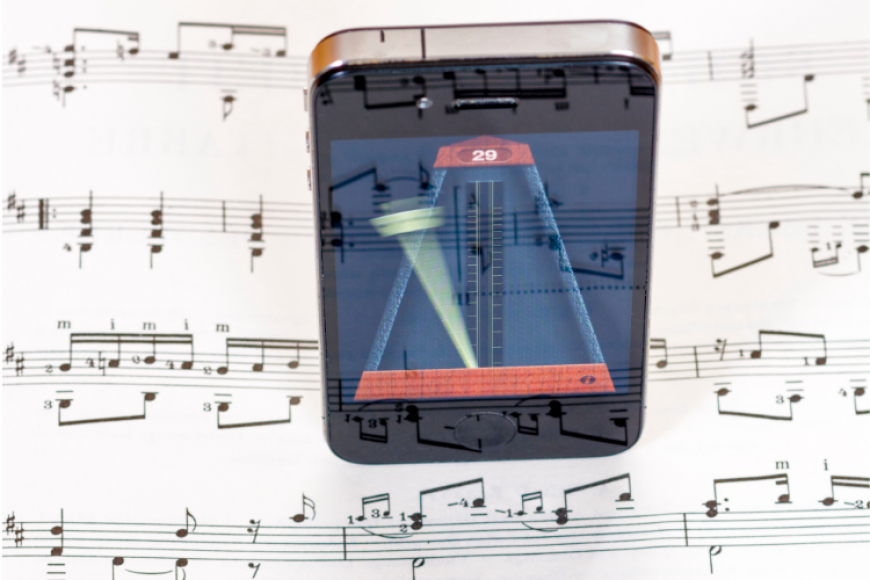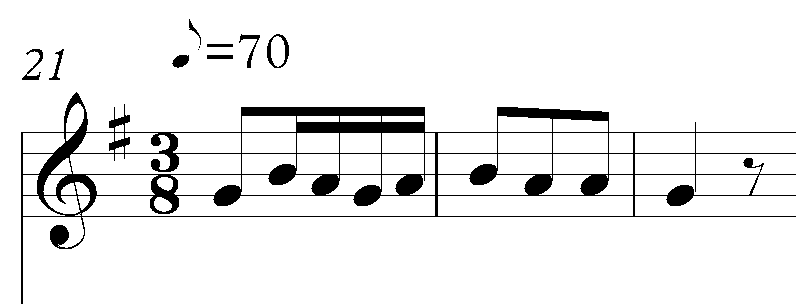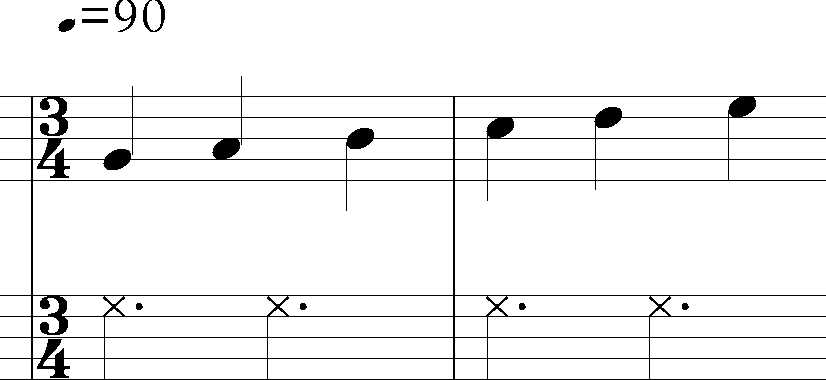Practicing With a Metronome: Why You Should Do It, and Tips to Get Started

Lígia Silva is a professional musician who teaches Music Theory lessons online. Find out more on her Lessonface profile.
Young students often say they play better without a metronome. This is likely because they don’t notice their rhythmic mistakes as they focus on other aspects of their practicing.
If you’re totally new to the metronome: it’s an app, or a website, (it used to be an object) where you can set a regular sound to play at a chosen speed. That speed is indicated as beats per minute and it usually ranges between 40 and 200.
For instance a 60 bpm will create beats at the same speed as the seconds of the clock. If the sheet music indicates a metronome marking of quarter note equals 80, this means you’ll have 80 quarter notes in each minute. With this information, you’ll also know in that piece you’ll have 160 eighth notes per minute and 40 half notes per minute. Therefore you can set the metronome at 80 and imagine it as playing quarter notes, at 40 bpm and imagine this as a half note, or at 160 and imagine it as the eighth note. This can be very useful in a lot of situations as we will see. Metronomes also let you create groups of beats and set different sounds for each beat inside that group, which enables you to simulate time signatures and create rhythmic patterns.
When you try to practice with a metronome for the first time it adds a few new tasks to your already busy brain: keeping track of time, predicting when the next beat will happen and adjusting your actions according to that timing. This is huge. So, when you first practice with the metronome you may miss some notes, your tone and posture may suffer, and you may even feel some anxiety. These first attempts with the metronome are often tiring and frustrating. All this is normal, because it’s difficult for the brain to divide its attention among all those simultaneous tasks, especially when they are not automatic. But it gets better with practice, and this effort really pays off.
Practicing with metronome will help you acquire some skills that are essential to any musician:
1. Stability of Pulse
Most musical genres and musical repertoire use an underlying regular pulse that helps organize all musical content in time. That’s what adds some rhythmic predictability to music and enables us to synchronize our movements with it, clapping or dancing for example. As a student you can record your practice and later try to clap along with it. If you can’t synchronize your claps with it, then probably you need to work with the metronome. Just set a moderate beat on the metronome (around 60-80 bpm) and try to play along with it.
At the beginning this can be difficult, so make it simple. First practice just playing a single note repeatedly with the metronome. The tempo we feel as more comfortable will depend on our technical abilities with the instrument and on our age. Kids usually prefer faster tempos. As we get older we tend to prefer slower tempos. There is no need to fight against this tendency when we are first practicing with a metronome. When you are comfortably and precisely playing single notes together with the metronome, add some melodic/technical difficulty (for example changing notes randomly, or playing chords or scales). Build upon the difficulty level until you’re able to play with the metronome some of the songs you’ve been studying.
Bear in mind that there is a finite amount of attention that you can spare at any given moment, so if the music you’re playing is close to the top difficulty level that you can handle now, then you may not be able to pay attention to the metronome. Our perception of synchronization is not always precise. Sometimes it may seem like we are playing together with the metronome, but we are slightly too early or too late. Ask your teacher to help you with this, or record yourself so you can listen for it. Also putting the metronome in an earphone, on just one side, may be very helpful, especially if you play a loud instrument or a wind instrument.
2. Synchronization
This point builds on the previous one. In fact, just to do the previous exercises you already need to synchronize with the metronome. But it’s one thing to be able to keep a steady beat on your own, playing solo, and quite another thing to be able to keep a steady beat while hearing someone else playing a part that is different from yours. This is important in group playing, and you can simulate that experience when you practice with the metronome. In the example below (Figure 1) the accompaniment keeps repeating the same rhythm. When you’re practicing the melody in the top voice if you set your metronome to play groups of 3 beats and you omit the second one (or just give it a softer sound) you’ll end up with the rhythm of the accompaniment. This can be a useful way to practice the melody on your own before you combine the two parts or voices.
fig 1:

Set the metronome to correspond to the accompaniment shown in Figure 2 by creating groups of eight beats (representing the eighth note in this case) and assign louder sounds to beats 1, 4, 5 and 7 (or mute all others if possible).
fig 2:

3. Feeling the Meter
Different time signatures call for different accentuations. The same melody written in 2/4 or in 3/4 will have a different feel. Most modern metronomes and metronome apps allow you to choose different sounds so you can have a distinct sound on every downbeat for example. That helps you feel the weight at the beginning of each measure and also keep better track of the rhythm. This can be very useful in long notes or repetitive passages that cross from one measure to the next.
4. Understanding Rhythmic Organization
Teacher says: “let’s practice this piece with the eighth note at 90 bpm” and the student replies: “Sorry, but my metronome just plays quarter-notes…’ As previously mentioned, rhythmical figures only express relative proportions, not exact values. They give us a range of relative durations, from shorter to longer, that we can use as we want.
The following three excerpts (Figures 3a, 3b, 3c) will all sound the same if played with a metronome at the tempos indicated, even though they are written using different rhythmic figures. If you’ve been playing for a while, Figure 3b will ‘look’ faster than Figure 4b. So don’t get fooled by the ‘psychological speed’ we tend to attribute to notation; always check the metronome mark.
fig 3a:

fig 3b:

fig 3c:

If we think about the range of rhythmic figures most commonly used, from the whole note to the 16th note, the quarter note will be the figure with a medium value. So most metronome markings will use the quarter note as the reference, since most musical pieces tend to have both longer and shorter values than the quarter note. But the metronome mark must be used to get an idea of the piece’s performance tempo, not necessarily as a tempo to use in our practice. We can use the metronome to correspond to any note value. Here are a few suggestions of how you can set the metronome to help practice your rhythmic precision .
Figure 4:

In this example (Figure 4), imagining the metronome as being the quarter note would be complicated. But you can imagine it as being the dotted quarter note. In fact, if you really want to practice precision, and/or if this excerpt belonged to a slow tempo, it could be useful to imagine the metronome as the eighth note, or even as a sixteenth note.
In the next example (Figure 5) using the metronome as the quarter note may not be the best choice as it may sound a bit stressful, especially if this excerpt was to be played fast. At a faster tempo one could set the metronome as the half note, or even as the whole note.
Figure 5:

But if the same melody was accompanied by quarter notes as shown in Figure 5a, then it could be useful to practice with the metronome as the quarter note, just to hear and feel how the whole thing will sound with both parts together.
Figure 5a:

Try to be creative: if you can imagine the metronome marking as a variety of different rhythmic figures, then you can hear and synchronize with those rhythms better when someone else is playing them in a song with you.
5. Mastering Finger Speed
If you’d like to work on your finger speed, precision, and articulation, using the metronome is a must. In fact, I often say that working on finger speed without a metronome is like training to run faster without using a chronometer. How can you clearly and doubtlessly measure your evolution without them? Practicing precision requires using a smaller rhythmic grid. The smaller the grid the more moments of contact/synchronization you’ll have, and easier it will be to monitor your precision. Let’s look back at Figure 4. Playing that music with the metronome on the 16th or the 8th note will give you many more points of contact between the notes played and the metronome, which will help you practice and evaluate precision much more easily. Playing that excerpt with the metronome on the dotted quarter note will require the musician to be aware of and feel all the subdivisions. This may result in a less precise performance if you don’t yet have solid rhythmic control.
6. Mastering More Complicated Rhythmic Patterns
If you’re a more experienced musician you can start using the metronome to challenge your rhythmic skills. For example, imagine it as the second half of each beat, or as the third part of the beat if you’re playing in swing. Create patterns with the metronome that either match, or really contradict the rhythmic characteristics of the piece you are playing. The next example (Figure 6) is a nice challenge that requires more advanced calculation and rhythmic skills.
Figure 6:

Imagine you play the top voice and set the metronome to do the bottom one. You’ll be playing a pattern of three notes in each measure while the metronome does a pattern of two. You’ll have to think that 90 quarter notes per minute means 30 measures per minute, which equals 60 dotted quarter notes per minute. So if you set the metronome at 60 bpm it will be playing the bottom voice, and you know you must be together with the metronome in one out of every two of its notes. You can even set a different sound for the first and the second dotted quarter notes to help you feel where you are in the measure. In this case it is useful to feel the subdivision (the eighth note) in order to synchronize this rhythm properly.
I hope all these suggestions have convinced you to start practicing with metronome, if you don’t do it regularly yet. If you’re already a metronome fan, I hope this post gave you some fresh ideas to use it in new ways.
 |
ABOUT LÍGIA SILVA
Lígia is a flutist and saxophonist, with professional experience on classical and jazz music. Graduate in classical flute and jazz saxophone, she studied in Portugal (ESMAE) and Belgium (Antwerp Conservatorium). With a master degree in musical education, she has been teaching kids and adults for the last 10 years. Along with a career on performance, she has done some original compositions exploring a mix of the jazz and classical genres. At the moment she is starting a PhD about the effects of music on our time perception. |
Lígia's lessons are rated five stars in 27 verified student reviews, like this one:
Lígia is a fantastic teacher, very talented and detailed oriented. She has a lot of musical knowledge and shares it with pleasure with her students.
-Igor Dutra, review from October 16, 2020




